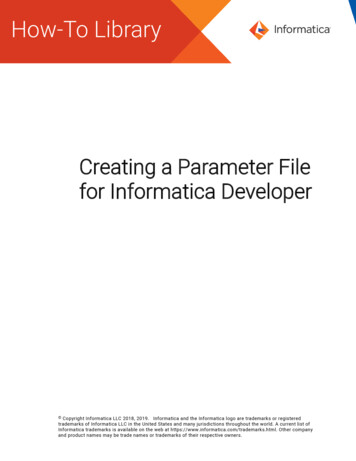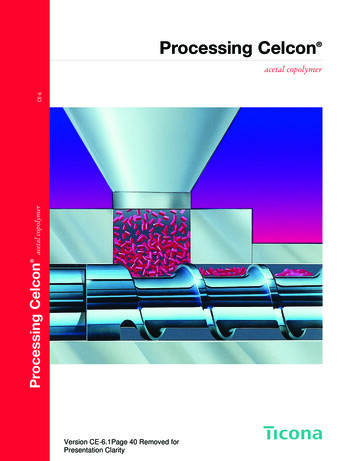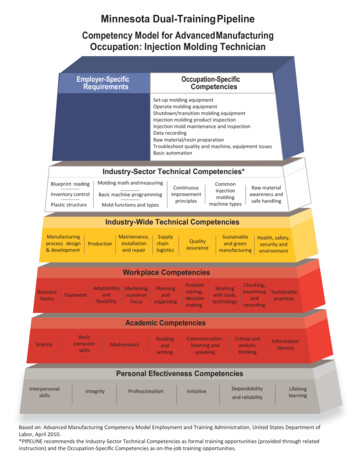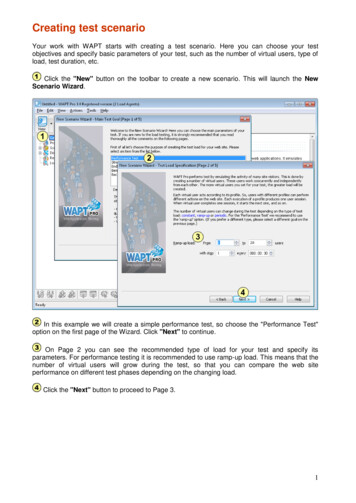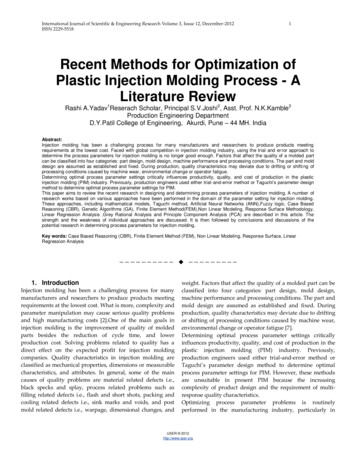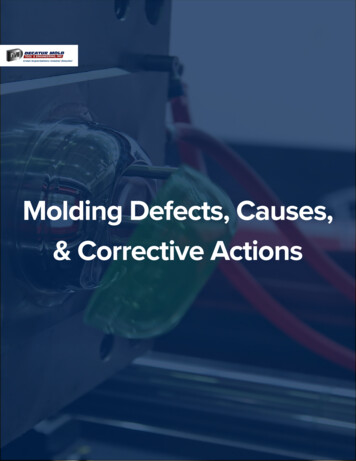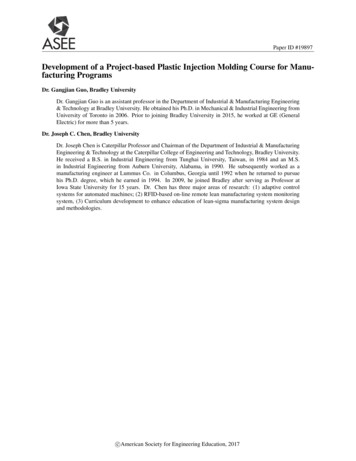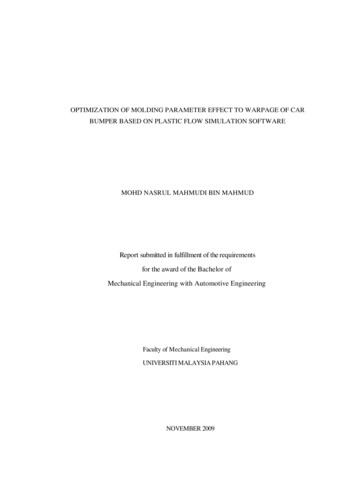
Transcription
OPTIMIZATION OF MOLDING PARAMETER EFFECT TO WARPAGE OF CARBUMPER BASED ON PLASTIC FLOW SIMULATION SOFTWAREMOHD NASRUL MAHMUDI BIN MAHMUDReport submitted in fulfillment of the requirementsfor the award of the Bachelor ofMechanical Engineering with Automotive EngineeringFaculty of Mechanical EngineeringUNIVERSITI MALAYSIA PAHANGNOVEMBER 2009
ABSTRACTThis research is specially focused on finding optimum molding parameter effect towarpage of a car bumper. The objectives of this research are to study the influence ofinjection molding parameters on a car bumper and analysis model car bumper usingplastic flow simulation software. The idea of this project came when injection moldingis the most widely used process in automotive industry. Since the qualities of injectionmolded plastic part are mostly influenced by process condition, how to determine theoptimum process conditions becomes the key to improving the part quality. Theoptimization of molding parameter effect is very important for the automotive industrybecause it gives beneficial effects in production costs due to less material being usedand shorter cycle times. In this project, plastic flow simulation method is proposed tooptimize the molding parameter effect to warpage of a car bumper. The car bumper willbe analyzing using three different parameters such as mold temperature, melttemperature, and injection pressure. This parameter will be changed to see the effect oncar bumper. The result shows that the plastic flow simulation method is an effective toolfor the process optimization of injection molding.
ABSTRAKPenyelidikan ini adalah memfokuskan kepada pencarian kesan parameter injectionmolding yang paling optimum ke atas bumper kereta. Objektif kajian ini adalah untukmengkaji pengaruh parameter injection molding ke atas bumper kereta dan menganalisismodel bumper kereta menggunakan perisian komputer ‘Plastic Flow Simulation’. Ideaprojek ini bermula apabila proses injection molding ini banyak digunakan secara meluasdalam bidang industri automotif. Disebabkan kualiti bahagian plastik injection moldingkebanyakannnya dipengaruhi oleh keadaan proses, untuk mencari keadaan proses yangpaling optimum menjadi kunci untuk meningkatkan lagi kualiti bahagian itu. Kesanparameter molding yang paling optimum adalah sangat penting dalam industri automotifkerana ia memberi lebih keuntungan dalam kos pengeluaran disebabkan oleh kurangnyabahan yang digunakan dan penggunaan masa yang lebih singkat. Dalam tesis ini,kaedah simulasi ‘plastic flow’ digunakan untuk mengoptimumkan kesan parametermolding ke atas bumper kereta. Bumper kereta itu akan dianalisis menggunakan tigaparameter yang berbeza seperti suhu acuan, suhu leburan plastic, dan tekanan suntikan.Parameter-parameter ini akan diubah untuk melihat kesan keatas bumper kereta.Keputusan menunjukkan kaedah simulasi ‘plastic flow’ ini adalah sangat berkesanuntuk mengoptimumkan proses injection molding.
TABLE OF CONTENTSPageSUPERVISOR’S DECLARATIONiSTUDENT’S ABLE OF CONTENTSviixLIST OF FIGURESCHAPTER lem Statement31.4Objectives of the Study31.5Scopes and Limitation31.6Organization of the Thesis4
CHAPTER 2LITERATURE REVIEW2.1Injection Molding52.2Machine Component62.2.162.32.4Injection SystemTheory of Injection Molding82.3.18The Operation of Injection MoldingParameter of Molding Process92.4.2.1 Identifying the Parameters92.4.2.2 Temperature2.5102.4.2.1 Melt Temperature Control102.4.2.2 Mold Temperature Control12Pressure132.5.1Injection Unit132.5.2Initial Injection Pressure132.5.3Holding Pressure (Secondary Pressure)142.5.4Back Pressure152.62.7Optimization Methodology152.6.1Causes of Warpage162.6.2Classifying the cause of Warpage16Moldflow192.7.120Moldflow Plastic Insight (MPI)
CHAPTER 3METHODOLOGY3.1Injection Molding223.2Flow Chart233.3Part Modeling243.4Material Selection243.5Plastic Flow Analysis253.5.1Analysis Sequence253.5.2Analysis26CHAPTER 4RESULTS AND DISCUSSION4.1Introduction274.2SolidWorks Software274.3Melt Temperature Analysis284.4Mold Temperature Analysis344.5Injection Pressure Analysis39
CHAPTER 5CONCLUSION AND REFERENCES49APPENDICESAMelt Temperature50BMold Temperature59CInjection Pressure68DSolidWorks Proton Saga Car Bumper77
LIST OF FIGURESFigure No.TitlePage2.1A single screw injection molding machine for thermoplastics62.2A reciprocating screw72.3(a) Nozzle with barrel in processing position. (b) Nozzle withbarrel backed out for purging.72.4Schematic of the injection molding process92.5Main processing parameters102.6Heating cylinder112.7Initial injection pressure132.8Holding pressure142.9Back pressure472.10Differential shrinkage for both unfilled and filled materials172.11Part warpage due to (a) non-uniform cooling in the part, and18(b) asymmetric cooling across the part thickness
2.12Larger volumetric shrinkage due to the high crystallization levelin the slow cooling areas leads to differential shrinkage and thuspart warpage182.13The poor cooling of the mold wall on the ribbed side causes aslower cooling of the material on that one side, which can lead topart warpage183.1Project flow chart244.1Fill time for different melt temperatures (a) 230 C (b) 240 C(c) 250 C4.24.34.4Air traps for different melt temperatures (a) 230 C (b) 240 C(c) 250 C29Volumetric shrinkage for melt different temperatures (a) 230 C(b) 240 C (c) 250 C30Weld lines for different melt temperatures (a) 230 C (b) 240 C(c) 250 C4.52831Deflection for different melt temperatures (a) 230 C (b) 240 C(c) 250 C32
4.6Fill time for different mold temperatures (a) 40 C (b) 50 C34(c) 60 C4.7Air traps for different mold temperatures (a) 40 C (b) 50 C35(c) 60 C4.8Volumetric shrinkage for different mold temperatures (a) 40 C36(b) 50 C (c) 60 C4.9Weld lines for different mold temperatures (a) 40 C (b) 50 C37(c) 60 C4.10Deflection for different mold temperatures (a) 40 C (b) 50 C38(c) 60 C4.11Fill time for different injection pressure (a) 20 MPa (b) 30MPa40(c) 40MPa4.12Air traps for different mold temperatures (a) 30 MPa (b) 40 MPa(c) 50 MPa414.13Volumetric shrinkage for different mold temperatures (a) 18 MPa(b) 20MPa (c) 22 MPa424.14Weld lines for different mold temperatures (a) 18 MPa (b) 20 MPa(c) 22 MPa43
4.15Deflection for different mold temperatures (a) 18 MPa (b) 20 MPa(c) 22 MPa44
CHAPTER 1INTRODUCTION1.1 IntroductionInjection molding is the most common method of production, especially in carmanufacturing from the smallest component to entire body panels of car. Injectionmolding can also be used to manufacture parts from aluminum or brass (die casting). Themelting points of these metals are much higher than those of plastics. This makes forsubstantially shorter mold lifetimes despite the use of specialized steels. Nonetheless, thecosts compare quite favorably to sand casting, particularly for smaller parts. Hence,majority of injection molding is applied to thermoplastic polymers. The process startedfrom heating thermoplastic material until it melts and forced into a steel mold. It coolsdown and solidifies before part is ejected.There are numerous variables affect the injection-molding process. In fact, arecent study itemized more than 200 different parameters that had a direct or indirecteffect on the process. It was found that the parameter can be categorized in three majordivisions: temperature, pressure, and time. An adjustment to any one of these has adirect influence on some, or all of the other parameter. For a minimum-defect, highquality production, it is critical to control as many parameters as possible. The more
parameters that are controlled, the higher the quality level of the products being molded.[6]Many companies always strive to produce high-quality parts while loweringtheir costs; however, significant time delays and increasing costs may occur if partdesign is not carefully evaluated or the injection process is not completely understood.Injection molding process allowed success in the production of newer material,especially for complex shape parts. Using injection molding technology, various partscan be made in shorter cycle times Therefore, optimization of molding parameter effectis very important for the industry.The process of injection molding offers many advantages which are unattainableusing other methods. Over the years, injection molding technology has developed into astandard and popular machining technology. In many operations, especially inautomotive industry, the injection molding process was chosen because of high qualitypart surfaces, good mechanical properties, low cost, and light weight. It also givesbeneficial effects in production costs due to less material being used and shorter cycletimes.1.2 BackgroundIn this study, the optimization of molding parameter effect to warpage of carbumper was investigated using plastic flow simulation software. The simulation wasconducted using different parameters like mold temperature, melt temperature, andinjection pressure. The objective of the process optimization is to select the optimalcontrol variables in injection molding under certain given constraints, in order to obtainthe best part quality. It is found that different values of parameter give different result of
finished molded product. A car bumper was modeled using CAD software before beinganalyzed using plastic flow simulation software.1.3 Problem statementThe objective of finding optimum molding parameter is to achieve high qualityproducts, cut product development, cycle times, and cost. Previously, productionengineers used trial-and-error method to determine optimal process parameter settingfor plastic injection molding. However, this method is unsuitable in present plasticinjection molding because the increasing complexity of product design and therequirement of multi-response quality characteristics However, the selection ofparameter is still not completed. For every parameter that had found, another wouldappear. Even items such as humidity and ambient temperature had an effect on themolding process. Although there are so many different variables, it is not impossible toget control of the injection-molding process. What is needed is a more practicalapproach to understanding all these parameters, and targeting those that have thegreatest effect on the overall quality and cost-effectiveness of finished molded product.1.4 Objectives of the studyThe objectives of this thesis are as follows:1. Study the influence of injection molding parameters effect to warpage of a carbumper.2. Analyze model car bumper using plastic flow simulation software.
1.5 Scope and limitation1. A proton saga car bumper was modeled using CAD software.2. The model car bumper will be analyzed using plastic flow simulation software.3. The parameter of injection molding process were selected such as moldtemperature, melt temperature, and injection pressure.4. Study the effect of warpage in injection-molded part.1.6 Organization of the thesisThis thesis consists of five chapters. Chapter 1 is the introduction about thisstudy. Chapter 2 is the review of literature which discusses the methods and findingspreviously done by the other people which are related to the study. Chapter 3 ismethodology which explains the approaches and methods used in performing the thesis.Chapter 4 is the chapter which reports the outcomes or results and discussion from theproject and chapter 5 consists of the recommendation and conclusion.
CHAPTER 2LITERATURE REVIEW2.1 Injection moldingInjection molding is one of the most exploited industrial processes in theproduction of plastic parts. Its success relies on the high capability to produce 3Dshapes at higher rates. The part of injection molding machines are mold clamp, ejectorpins, moving die, stationary die, barrel hopper and motor. The pellets or granules are fedinto the heated cylinder, and melt is forced into the mold either by a hydraulic plungeror by the rotating screw system of an extruder. As in plastic extrusion, the barrel isheated externally to promote melting of the polymer. In injection molding machines,however, a far greater portion of the heat transferred to the polymer is due to frictionalheating.Modern machines are of the reciprocating or plasticating screw type with thesequence of operation. As the pressure builds up at the mold entrance, the rotating screwbegins to move backward under pressure to a predetermined distance. This movementcontrols the volume of material to be injected. The screw then stops rotating and ispushed forward hydraulically, forcing the molten plastic into the mold cavity. Thepressure developed usually range from 70 to 200 MPa.
For thermoplastic, the molds are kept relatively cool at about 90ºC. Thermosetpart are molded in heated mold at about 200ºC, where polymerization and cross-linkingtake place.After the part has cooled sufficiently (for thermoplastic) or cured (for thermoset),the molds are opened and the part is removed from the mold using ejector. Elastomersalso are injection molded into discrete products by this processes. Because the materialis molten when injected into the mold, complex shapes with good dimensional accuracycan be obtained.2.2 Machine components2.2.1 Injection systemThe injection system consists of a hopper, a reciprocating screw and barrelassembly, and an injection nozzle, as shown in Figure 2.1. This system confines andtransports the plastic as it progresses through the feeding, compressing, degassing,melting, injection, and packing stages.FIGURE 2.1: A single screw injection molding machine for thermoplastics.·The hopperThermoplastic material is supplied to molders in the form of small pellets. The hopper
on the injection molding machine holds these pellets. The pellets are gravity-fed fromthe hopper through the hopper throat into the barrel and screw assembly. [9]·The barrelAs shown in Figure 2.1, the barrel of the injection molding machine supports thereciprocating plasticizing screw. It is heated by the electric heater bands. [9] The reciprocating screwThe reciprocating screw is used to compress, melt, and convey the material. Thereciprocating screw consists of three zones (illustrated below):1.the feeding zone2.the compressing (or transition) zone3.the metering zoneFIGURE 2.2: A reciprocating screw·The nozzleThe nozzle connects the barrel to the sprue bushing of the mold and forms a sealbetween the barrel and the mold. The temperature of the nozzle should be set to thematerial's melt temperature or just below it, depending on the recommendation of thematerial supplier. When the barrel is in its full forward processing position, the radius ofthe nozzle should nest and seal in the concave radius in the sprue bushing with alocating ring. During purging of the barrel, the barrel backs out from the sprue, so thepurging compound cans free fall from the nozzle. These two barrel positions areillustrated below [9]:
FIGURE 2.3: (a) Nozzle with barrel in processing position. (b) Nozzle with barrelbacked out for purging.2.3 Theory of injection moldingThe theory of injection molding can be reduced to four simple individual steps:Plasticizing, Injection, Chilling, and Ejection. Each of those steps is distinct from theothers and correct control of each is essential to the success of the total process. [8]1.Plasticizing - describes the conversion of the polymer material from its normalhard granular form at room temperatures, to the liquid consistency necessary forinjection at its correct melt temperature.2.Injection - is the stage during which this melt is introduced into a mold tocompletely fill a cavity or cavities.3.Chilling - is the action of removing heat from the melt to convert it from a liquidconsistency back to its original rigid state. As the material cools, it also shrinks.4.Ejection - is the removal of the cooled, molded part from the mold cavity andfrom any cores or inserts.Repetition of these basic steps in sequence is the process of injection2.3.1 The operations of an injection molding are:1) Closing the mold: the mold closes so the cycle can begin.2) Plasticizing the resin: (Figure 2.4a) the hopper feeds solid pellets or grains of theplastic resin into the barrel where it becomes molten due to the heating bands and
friction caused by the rotating screw. The molten plastic accumulates at the front of thebarrel (the nozzle side) as the screw retracts to the rear of the barrel.3) Injecting the resin: (Figure 2.4b) when enough molten plastic has accumulated for afull shot, a valve in the nozzle is opened and the screw rapidly advances forward,quickly injecting the plastic into the mold cavity.4) Cooling the part: (Figure 2.4c) The screw continues to push plastic into the mold inorder to create a holding pressure. This ensures adequate filling. As this happens, themolten plastic begins to cool and solidify toward the inside. This natural cooling isexpedited by convection due to coolant flowing through channels inside the mold.5) Ejecting the part: (Figure 2.4d) After adequate cooling time has elapsed, the mold isopened. Some sort of ejector device is actuated in this process and the part is ejectedfrom the mold and collected. After this, the cycle repeats from step 1.Figure 2.4: Schematic of the injection moldingprocess
2.4 Parameter of the molding process2.4.1 Identifying the parametersThere are numerous variable affect the injection molding process. For instance,injection pressure consisted of more than one item. There are initial injection pressures,second and up to fifth stage injection pressure, holding pressure, back pressure, and linepressure. All of these give direct effect on each other. Humidity and ambienttemperature also have effect on the molding process. Shift changes, relief operators, fanblowing, housekeeping, age of equipment, size of machine, location of press, pressureof cooling water, all seemed to have direct or indirect effect on the injection moldingprocess.Figure 2.5 shows that all of the parameters involved can be placed into two maincategories: temperature and pressure. All these relative importance of the categories isshown by size of the circles. Thus, temperature is the most important, followed bypressure. However, each is dependent on the other, and changing one will affect one orall of the others. [6]TemperaturePressureFigure 2.5: Main processing parameters
2.4.2 TemperatureA variety of temperatures affect the injection molding process, ranging frommelt temperature to mold temperature, and including even ambient temperature.2.4.2.1 Melt Temperature ControlMelt temperature is the temperature at which the plastic material is maintainedthroughout the flow path. This path begins where the plastic material is transferred fromthe machine hopper into the cylinder of the injection unit. Then the material is augeredthrough the heating cylinder and into the machine nozzle. From there it is injected intothe mold, where it must travel along a runner system (if one exists), through the gates,and into the cavities that are machined into the mold. The temperature of the melt mustbe controlled along the path, starting with the heating cylinder. [6]Figure 2.6 shows the heating cylinder is wrapped with heater bands. These areelectrical heaters shaped like hinged bracelets that mount around the outside of theheating cylinder. There are three main heating zones to the heating cylinder: the rearzone, the center zone, and the front zone. In addition, there is usually at least one heaterband fastened around the machine nozzle, an area referred to as the nozzle zone. [6]Figure 2.6: Heating cylinderThe plastic for the injection process should be brought up to proper temperaturegradually as the material drops from the hopper into the rear zone, where the initial heatbegins to soften the material. Then the material is augered forward by the screw into the
center zone where the temperature is generally 10 to 20 F (5.6 to 11 C) higher than thein the rear zone. As the material travels to the front zone, the temperature is gainincreased by 10 to 20 F, and finally the material is ready to be injected into the mold. Itis held at this point until the previous molding cycle is complete, at which time the moldopens, parts are ejected, the mold closes, and the next cycle begins. The charge ofpreheated plastic is then injected into the mold. [6]Besides absorbing heat from the externally mounted heater bands, the plasticmaterial absorbs a large amount of heat from the friction caused by the augering actionof the injection screw. The screw rotates to bring fresh material into the heating cylinderand prepare it for the coming cycle. While being pulled along, the new material issqueezed between the flights of the screw and the inside wall of the injection barrel. Thefriction generates heat, which is absorbed by the plastic. [6]The main point here is that plastic must be heated to the proper temperature forinjection. Melt temperature is measured at the nozzle as the plastic exit the machine,before it enters the mold. It is measured by taking an “air shot” and plunging a probefrom a measuring instrument with a fast response time (1 second id acceptable) into theplastic melt. An air shot is made with the injection sled pulled back so the injection unitdoes not touch the mold. The material is then released as in a normal cycle, but it isinjected into air rather than the mold. It is allowed to fall onto a tray made for thepurpose and its temperature is then quickly measured. The temperature at that pointshould be within 10 F (5.6 C) of the desired temperature. [6]2.4.2.2 Mold Temperature ControlThe plastic material is now ready to flow into the mold. First, it must travelthrough the machine nozzle, which is the last heating zone provided by the machine.After the material exits the nozzle and enters the mold, it immediately begins to cooldown as the mold absorbs heat from it. The rate at which this heat is absorbeddetermines how far the plastic will flow before it begins to solidify and stop moving.Each product depending on its design and plastic material, demand specific coolingrates, and this rate of cooling is critical to product quality. Therefore, the mold
temperature must be regulated in order to regulate the cooling rate of the plastic. This isdone by connecting the mold to a temperature control unit that normally utilizes wateras medium. The water is circulated through the mold and held at a preset temperature byheating or cooling in cycles. [6]Every combination of plastic and product has a specific temperature at which themold should be maintained to ensure quality molding. The mold temperature ismeasured directly from the molding surface of the tool with a solid probe on apyrometer device. Usually, readings from several areas are averaged. The object of thecooling process is to lower the temperature of the molded plastic to the point at which itsolidifies again. When the plastic reaches that point, it can be ejected from the moldwith relative structural safety. That simply means that the plastic part will not moveexcessively, causing warpage, twisting, or other shrinkage related problem as the plasticcontinues to cool. [6]2.5 PressureThere are two areas in the injection machine that required pressure and pressurecontrol: the injection unit and the clamp unit. They are closely related in that they areopposing pressure – the clamp unit must develop enough clamp pressure to overcomethe pressure developed by the injection unit during the molding process.2.5.1 Injection unitThree basic types of pressure are developed by the injection unit: initialpressure, hold pressure, and back pressure.
2.5.2 Initial Injection PressureThis is the first pressure that applied to the molten plastic. It develops as resultof main system hydraulic pressure pushing against the back end of the injection screw(or plunger) (figure 2.7).Figure 2.7: Initial injection pressureThe amount of pressure developed by the main system is on the order of 2000psi (13,789 kPa). Some systems are capable of producing more than that, but 2000 psi isthe most common line pressure. This pressure is converted to a maximum of 20,000 psi(137,890 kPa) at the nozzle of the injection unit (where the plastic first enters the mold)by the design and shape of the injection screw. In most cases, the full 20,000 psi is notrequired for filling a mold, and most products can be molded in a range of from 5000 to15,000 psi (34,472 to 103,418 kPa). The pressure actually required depends on theplastic being molded, the viscosity and flow rate of the plastic, and the temperatures ofthe plastic and the mold. [6]To summarize, initial injection pressure is used to create the initial filling of themold. It should be set at the highest practical value to fill the mold with the fastestpractical speed.
The parameter of injection molding process were selected such as mold temperature, melt temperature, and injection pressure. 4. Study the effect of warpage in injection-molded part. 1.6 Organization of th
